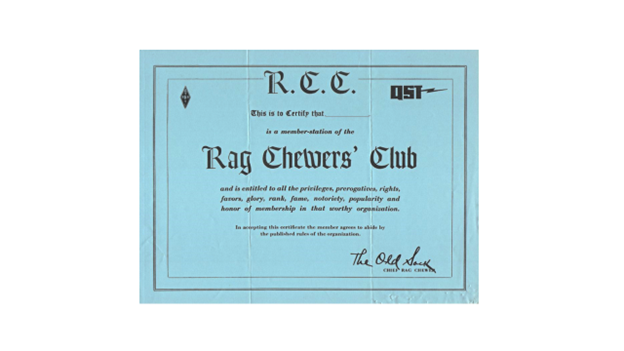How long are your QSOs? If you’re a contester, they’re likely done in seconds. Operating FT8, your semi-automated QSOs exchange call signs, locations, and signal reports—all in about 90 seconds. Those seeking WAS (Worked All States award) may keep conversations short in order to find more states. What happened to casual chats on the HF bands or your local repeater?
Not What You Think
I asked my 15-year-old grandson and his 40-something father what rag chewing meant. I got an “Ewwww, gross” from one and a blank look from the other. Neither is a ham.
The phrase “chewing the rag” is known to have been used since the Middle Ages. One explanation says “chew” was slang for “talk,” and “rag” is derived from “fat” or is a reference to the tongue. “Chewing the rag” thus became a phrase meaning casual conversation, frequently while sitting around a meal, and later, when chatting on the radio.
“Ragchew” refers to an informal conversation on amateur radio that generally involves two or more people. Generally, rag chewing involves talking about hobbies, interests, and current news. It’s common for these conversations to veer off topic or to take on an informal and laidback tone.
It’s usually considered a recreational and social activity that is both for enjoyment and camaraderie. But rag chewing can also be educational since it can provide users with the opportunity to practice their radio communication skills, share ideas and knowledge about the hobby, and find out about new ham radio activities.
Rag Chewer Awards
The Rag Chewers Club (RCC) was one of the easiest awards a ham could earn. To qualify, you only needed to provide evidence that you made a single radio contact that lasted more than 30 minutes. It was created to encourage hams to go beyond a short signal report/location QSO and actually engage in a friendly, meaningful conversation.

Its original intent was to offer a warm welcome into ham radio by offering an award certificate that would be prized, yet obtainable by newcomers. All you had to do was apply and include verification of the QSO—it was free.
For years the award had been offered by the American Radio Relay League (ARRL). However, in 2004 it was discontinued, probably due to the cost of the award. The award was rescued by The Society for the Preservation of Amateur Radio (SPAR), which now has been disbanded. Some other groups have picked up the slack, including the Straight Key Century Club (SKCC).
About five years ago, the ARRL was reconsidering sponsorship and took a survey of hams in November 2018. However, there has been no mention since then about an RCC revival on the ARRL’s website.
What Can You Talk About?
Your first contact can be a bit intimidating. For that reason, it might be a good idea to arrange a QSO with a friend or someone in your radio club.
After the call sign exchange, signal report, op name and location, the usual topics include local weather, equipment you’re using (radio, antenna, mic, etc.), and then whatever you feel like discussing. Other subjects might include hobbies, how long you’ve been a ham, occupation, pets, and more.
Discussions of politics, religion, and other potentially controversial topics could attract controversy and provoke arguments on the air. If it looks like your conversation is going sideways, it might be a good idea to change the topic or conclude the contact.
You might be fortunate enough to make contact with a foreign (DX) station. Some speak limited English, so take that into consideration. If they are conversant in English (or you are conversant in their native language), you can always tell them a little about yourself and your local area and ask them about theirs. Or you could tell them what ham radio is like in the U.S., as well as discuss your involvement in amateur radio clubs and organizations.
Continuing the Conversation
Many contacts that take place on the HF ham radio bands are what we call “rubber stamp” contacts. These QSOs consist of a set format and do not normally involve long conversations. There are a number of reasons for this, such as contests that have time constraints, the limitations of some digital modes, or crowded DX pileups.
However, many ham radio operators like to talk about far more than is contained within the basic contact. Often technical discussions may be heard, or ham stations may be describing the part of the world where they live. Maybe you’ll connect with a gregarious ham and have that half-hour talk.
Fellow rag chewers, let’s stamp out the rubber stamp QSO!

